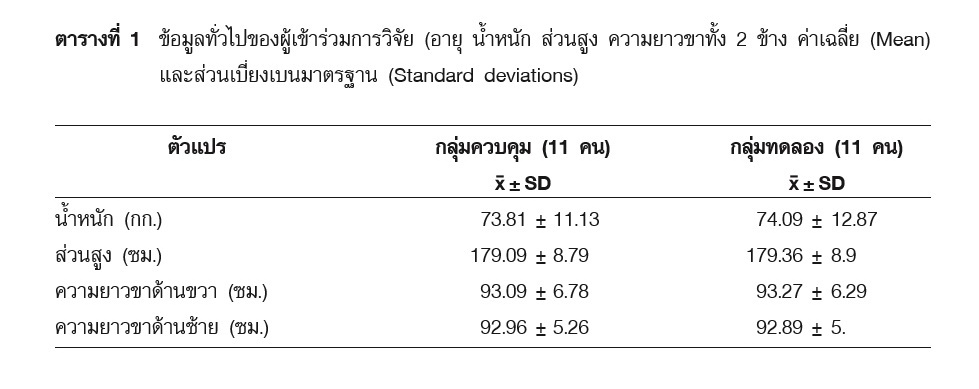COMPARATIVE EFFECTS OF STAR EXCURSION BALANCE TRAINING WITH AND WITHOUT ANKLE DISC ON DYNAMIC BALANCE IN YOUNG BASKETBALL PLAYERS WITH CHRONIC ANKLE INSTABILITY
Main Article Content
Abstract
Purpose : The purpose of this research was to study and to compare the effect of star excursion balance training with and without ankle disc on balance in young basketball players with chronic ankle instability.
Methods : Twenty-two young male basketball players between 13-16 years old from Assumption college participated in this study. Twenty-two were divided into 2 groups (n=11/ group): the experimental group (Star excursion balance training with ankle disc, SEBTR+AD) and the control group (Star excursion balance training with ankle disc, SEBTR). Both groups were trained three times per week for four weeks. Ankle functional performance tests and balance tests performed on Biodex Balance System SD, were taken before and after the experiment. Data were analyzed using mean and standard deviation, and t-test was employed to determine the significant differences of the data before and after the experiment and between the experimental and control groups.
Results : After 4 weeks of training, there were no significant differences in balance variables and ankle functional performance between the control and the experimental groups (p<.05)
Conclusion : A star excursion balance training with and without ankle disc could lead to improvements of balance and ankle functional performance in athletes with chronic ankle instability
Article Details
References
Boccolini, G., Brazzit, A., Bonfanti, L., & Alberti, G. (2013). Using balance training to improvet the performance of youth basketball players. Sports Sciences for Health 9(2):37-42.
Borao, O., Planas, A., Beltran V., & Corbi, F. (2015). Effects of a 6-week neuromuscular ankle training program on the Star Excursion Balance Test for basketball players. Apunts. Medicina de l’Esport 50(187): 95-102.
Chan, K., Ding, B., & Mrocek, K.(2011). Acute and chronic lateral ankle instability in the athlete. Bulletin of the NYU hospital for Joint Diseases 69(1): 17.
Chaiwanisiri, D., Lorprayoon, E., & Noomanoch, L. (2005). Star Excursion Balance Training: Effects o Ankle Functional Stability after Ankle Sprain. Journal of the Medical Association of Thailand. 88 (4): 90-94.
Clark, V.M., & Burden, A.M. (2005). A 4-week wobble board exercise programme improved muscle onset latency and perceived stability in individuals with a functionally unstable ankle. Physical Therapy in Sport 6(4): 181-187.
Czajka, C., Tran, E., Cia, A., & DiPerta, J.(2014). Ankle sprains and instability. Medical Clinics of North America 98(2): 313-329.
Gutierrez, G., Kaminski, T., & Douex, A. (2009). Neuromuscular control and ankle instability. PM&R 1(4): 359-365.
Gauffin, H., Troop, H., & Odenrick, P. (1988). Effect of Ankle Disk Training on Postural Control in Patients with Functional Instability of the Ankle Joint. International Journal of Sports Medicine 09(2): 141-144.
Hertel, J. (2002). Functional anatomy, pathomechanics, and pathophysiology of lateral ankle instability. Journal of Athletic Training 37(4): 364.
Hootman, J.M., Dick, R., & Agel, J.(2007). Epidemiology of Collegiate Injuries for 15 Sports: Summary and Recommendations for Injury Prevention Initiatives. Journal of Athletic Training 42(2): 311-319.
Hoffman, J. R. (2008). Physiology of basketball. Handbook of sports medicine and science: Basketball: 12-24.
Holmes, A., & Delahunt, E.(2009). Treatment of common deficits associated with chronic ankle instability. Sports Medicine 39(3): 207-224.
Kaminski, T., Hertrl, J., Amendola, N., Docherty, C., Dolan, C., Hopkins, J., .... Richie, D.(2013). National Athletic Trainers’ Association position statement: conservative management and prevention of ankle sprains in athletes. Journal of Athletic Training 48(4): 528-545.
Klers, H., Brumagne, S., & Van Dieen, J.(2012). Ankle proprioception is not targeted by exercises on an unstable surface. European Journal of Applied Physiology 112(4): 1577-1585.
Martin, R., Davenport, T., Paulseth S., Wukish, M., & Godges, J.(2013). Ankle stability and movement coordination impairments: Ankle ligament sprains. Journal of Orthopaedic & Sports Physical Therapy.
McKeon, P., Ingersoll, C., Kerrigan, D., Saliba, F., Bennett, B., & Hertel, J.(2008). Balance training improves function and postural control in those with chronic ankle instability. Medicine Science in Sports and Exercise 40(10): 1810.
Mettler, A., Chinn., L., Susan, A., Saliba, A., McKeon, P., & Hertel, J.(2015). Balance training and center-of-pressure location in participants with chronic ankle instability. Journal of Athletic Training 50(4): 343-349.
Riva, D., Bianchi, R., Rocca, F., & Mamo, C.(2016). Proprioceptive training and injury prevention in a professional men’s basketball team: a six-year prospective study. Journal of Strength and Conditioning Research 30(2): 461.
Roijezon, U., Nicholas, C., & Treleaven, J.(2015). Proprioception in musculoskeletal rehabilitation. Part 1: Basic science and principles of assessment and clinical interventions. Manual Therapy 20( 3): 368-377.


